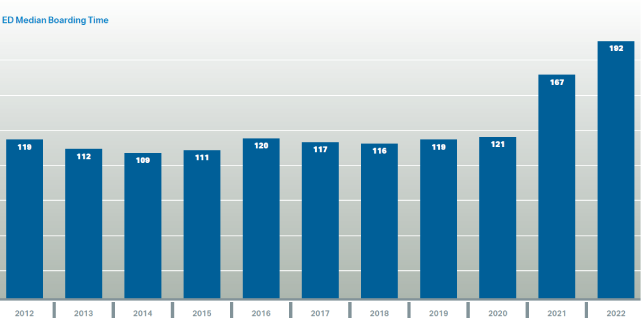
Boarding time increases led to unprecedented ed walkaway rates. The percentage of patients who leave the ED prior to the completion of treatment increased to a stunning 4.9 percent in 2022, continuing its upward climb from 4.0 percent in 2021, 2.8 percent in 2020 and 2.7 percent in 2019. Even freestanding EDs saw a significant increase in walkaway rates, from 1.6 percent in 2019, to 2.7 percent in 2022. The overall rate of 4.9 percent in 2022 is unprecedented, troubling, and indicates significant dissatisfaction with the delivery of acute, unscheduled care. In 2020, U.S. EDs saw a total of 137 million patients. The walkaway rate of 2.8 percent that year meant that about 3.84 million ED visits ended prematurely. The increase in LBTC rates to 4.9 percent in 2022, combined with an estimated 155 million ED visits, means that about 7.6 million patients walked away. That is almost double in just two years.
Explore This Issue
ACEP Now: Vol 42 – No 12 – December 2023Due to hospital boarding, it appears that ED leaders and emergency physicians cannot provide care that is timely and satisfies patients if the ED remains congested with inpatients. Inpatient boarders also take significant time and energy of the available ED nurses and techs, which leaves those individuals unable to assist in caring for the steady flow of new patients. Prior research shows that boarders worsen mortality; anecdotes from ACEP members echo the data.2,3 A solution to the boarding crisis is needed.
Emergency physicians have an opportunity to reduce walkaway rates by improving the timing to get to a decision, either to discharge or to admit. Many EDs have reduced the door to provider time, as evidenced in the reduction in that metric over many years. But if the admitted patient cannot be moved out of an ED bed, and it remains the responsibility of the ED nurses and techs to provide care for boarded patients, emergency physicians cannot marshal the resources to make the flow work, patients of all types have their hospital care compromised, and a large number will walk away not knowing if they have an emergency medical condition or not.
 Dr. Augustine is national director of prehospital strategy for US Acute Care Solutions based in Canton, Ohio; clinical professor of emergency medicine at Wright State University in Dayton, Ohio; and vice president of the Emergency Department Benchmarking Alliance.
Dr. Augustine is national director of prehospital strategy for US Acute Care Solutions based in Canton, Ohio; clinical professor of emergency medicine at Wright State University in Dayton, Ohio; and vice president of the Emergency Department Benchmarking Alliance.
References
- Rahman NA, Hemmer KC, Pines JM. ED boarding. ACEP Now. Published August 1, 2023. Accessed November 29, 2023.
- Boudi Z, Lauque D, Alsabri M, et al. Association between boarding in the emergency department and in-hospital mortality: A systematic review. PLoS One. 2020;15(4):e0231253.
- American College of Emergency Physicians. A nation in crisis: Real stories from the front lines. ACEP website. Accessed November 29, 2023.
Pages: 1 2 3 | Single Page




No Responses to “A Sobering Year for Emergency Departments and Their Patients”